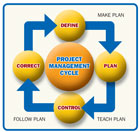
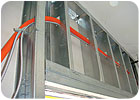
The interior of the opening for a sliding glass door to a terrace.
It’s no secret that pre-planning and using quality materials are the best ways to achieve high production safety and quality goals. It is also well known that, in construction, the framing phase of the work has a significant impact on the drywall and taping/finishing operations on the project. Likewise, installing a superior exterior framing substrate when installing a plaster or EIFS finish is equally important.
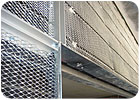
The exterior of the opening for a sliding glass door to a terrace.
Planning for Success
Project planning should be led by the project manager. However, it is everyone’s responsibility to properly plan their work to achieve the company’s goals. In a labor-intensive business like metal stud framing, drywall, taping/finishing or plaster operations, the costs of labor consumes 70 to 75 percent of the budget for each line item. With this in mind, it makes sense to pre-plan and install the best-performing materials in the industry.Material costs are insignificant when properly weighed against potential production gains or losses. A 15 to 20 percent material increase is a good bet when the production increase is also 20 percent or better.
This example, using a $1,000 budgeted line item illustrates this concept.
Labor cost = 70 percent – Material cost = 30 percent of your $1,000.00 budget.
• 70 percent Labor is = $700.
• A 20 percent savings of $700 = $140
• 30 percent materials cost = $300.
• A 20 percent savings of $300 = $60
So, this simple formula shows that you can be more than twice as effective in saving 20 percent on labor than you can by saving 20 percent on materials.
When considering a $100,000 budgeted framing line item, it makes sense to spend $6,000 more on material to save $14,000 on labor while also setting up your drywall and taping finishing crews for higher production and additional cost savings, not to mention superior quality.
Many times contractors get so involved in material buyout they actually get a whiplash effect once the work starts. The material budget is looking good at the time of the initial buyout. However, when poor pre-planning and poor materials are used and material price was the governing factor for the purchase, once the field starts the installation more labor is spent than needed. Often it is the case that even more time is spent by the following drywall, taping and paint trades in an attempt to achieve a quality-finished product. These lost man-hours add up and are never recovered.
Let’s take a look at the inefficiency of using cheap materials and poor material designs, again by using a $1,000 budget. This figure will also be slightly discounted for poor quality and poor safety. This is a real-world view of how these elements work (or do not) together.
Labor cost = 70 percent – Material cost = 30 percent of your $1,000.00 budget.
• 70 percent labor = $700
• Consider a 20 percent increase in the loss in production due to poor materials = $140
• An additional safety discount of 5 percent = $35 and a quality [rework] discount of 5 percent = $35
• Total labor loss = $210
• Total Loss to Labor is 30 percent, or $210
• 30 percent materials = 30 percent of $1,000 = $300 consider a 15 percent saving of $300 = $45 savings
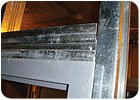
Steel framing without drywall
Make a plan, Teach the plan
Pre-Planning = Profits
• Pre-Planning: noun. (organized thinking); the act of planning, setting up to be efficient.
• The opposite: unplanned, unorganized.
Pre-planning is the single most effective thing you can do to make additional profit or reduce loss.
Effective pre-planning is documented in written form and transferred from the “get work” side of the business to the “do work” side of the business. It is critical that the “Plan” gets transferred to the field operations and each installer. If your pre-planning does not get properly documented, engineered, submitted and installed, the project does not make you money. You must have effective pre-planning to achieve the best Production, Safety, and Quality.
Production = Profits
• Production: noun. (efficient); installing in an efficient manner.
• The opposite: unfocused, Rework
High production is the result of effective pre-planning. The pursuit of high production should never compromise safety or quality. When safety is compromised and a lost-time accident occurs you potentially lose months of high production all at once. When quality is overlooked, the production gains realized are lost or significantly reduced by necessary rework at a later time or by a following trade.
Safety = Profits
• Safety: noun. (injury Free); providing a healthy, safe work environment. Low risk
• The opposite: injured, sick, preventable risk.
To put it simply, safety should never be compromised. Take the appropriate measures to prevent accidents before they happen. Nothing can cost your business more money than a poor safety record. Insurance compensation rates alone will kill your business.
Quality = Profits
• Quality: noun. (Superior); providing an excellent product or service.
• The opposite: Inferior
Quality starts with good materials installed in a professional manner, correctly the first time. Poor quality materials and/or poor material designs make production, safety and quality impossible no matter how much you pre-plan.
A well-planned metal stud framing design, using smart components and assemblies is the beginning of a successful job.
A flat framing substrate makes for the best exterior plastering production and quality finished product (same applies with EIFS). Likewise, a flat framing substrate provides the best interior drywall and taping productions and quality, finished product too
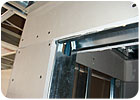
Drywall installed flat against the steel
Teach Plan - Follow Plan
Many times the metal stud framing details or designs on a project are simply just lines in the bid set of drawings, lines that, in this day and age, have been cut and pasted from project to project. This is not a bad thing; as a matter of fact for a smart contractor that knows how to effectively bid, qualify, pre-plan, engineer, schedule and install the work, it’s a great opportunity to make some money.Non-load bearing metal stud framing is simple when it comes to standing vertical studs in horizontal tracks. Metal framing designs become more complicated at 1) Fancy Ceilings, 2) Construction Joints, 3) Backing & Bracing, and 4) Rough Opening framing. Exterior designs that involve wind and seismic loads can also be very challenging. It is not uncommon for these four framing locations to account for over 50 percent of a framing budget and more than likely be the source of any framing losses.
On a 41-story tower condominium project in Los Angeles, the project plans -- although complete enough to bid the project -- were not complete enough to build from, without several RFIs. Also, a good amount of pre-planning and redesigning the framing components and methods were necessary, not only to build the project but to complete it on time and on budget.
At first glance this project appeared to be a simple tower of repetitive work. The contractor might have been inclined to say, “This is simple: Get the learning curve down and blast up the tower.” Not so quick. This building is complicated.
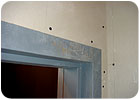
Clean and flat drywall around the door frame and in the corner
Condo Elegance in L.A.
High Rise condo towers in Los Angeles command big dollars per square foot, so the ceilings must be beautifully detailed and finished. When slab heights permit, the ceilings in the ballrooms and lobby areas are embellished “to the nines.”On this project, Martin Brothers/Marcowall, a prominent Los Angeles-based specialty contractor chose USG’s snap grid system because it provides a smooth and high-quality framing substrate and snaps together like a T-bar grid system.
The towers’ suites in the top floors need to have a UL- and ICC-approved life safety firestop system installed at the top of every wall. This makes pre-planning, approved fire life safety head-of-wall joint system choices, and submittal work very important early in the project’s schedule and well before the work ever starts.
With relatively low ceiling heights and exposed ceilings in some locations it is important to have a smooth (flush) head-of-wall joint. Sliptrack Systems, slotted track was used as top track at all the walls. They are ICC- and UL-approved for fire ratings up to four hours. The slotted track design not only helped to save framing labor, it required less drywall and taping work. Using this track also eliminated rework because the studs are in a fixed location and are not moved during other trade’s operations.
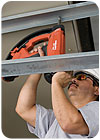
Backing and Bracing Built in for Strength
Backing and bracing is needed at several locations for various reasons. Bracing is needed to support and stabilize knee walls or short drop soffits from the deck above. Backing allows for wall-mounted equipment to anchor to the walls. Back-to-back studs and clip-framing methods are used for quick and strong bracing requirements.Tom Castle S.E. of Ficcadenti Waggoner and Castle was employed to make efficient connections while not penetrating the (PT) post tension slab with fasteners. Pin and fasteners had to be less than ¾-inch deep. Two methods were used:
1.) 3/4-inch Hilti shot pins were used at lighter load areas
2.) 3/4-inch wood form insert Blue Bangers design was used at higher load areas.
The 3/4-inch pins and wood form insert Blue Bangers were selected for two reasons: First, meeting code and connection strength and; second, speed and accuracy of installation. It is important when a pin or insert is installed that it will remain in place. Both methods are very effective in PT slab applications where the pin penetrations must stay within the ¾ inch depth.
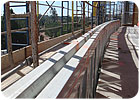
A three-piece unit for this exterior radius was constructed to replace the 12-piece assembly that was originally specified for the building. This significantly reduced labor on the jobsite.
Rough Openings - Doors and Windows Show the View
Every door and window (interior or exterior) needs a stud framed rough opening. Every floor has over 100 doors and windows. Most of the rough openings are both single and double interior doors. The plans showed traditional built up box headers and double jamb studs.Martin Brothers/Marcowall requested an (EJ) Engineering Judgment and full submittal package to use Brady’s ProX Header, to save framing labor and provide a smooth framing substrate for better drywall and taping production.
Using a single piece 20-gauge ProX Header at each door opening removed 2,000 studs from the project. It also eliminated header assembly time. Brady provided a complete submittal package that included switching the double jamb studs (shown in the drawings) to using a single [upgraded] wide flange 2-inch jamb stud. This removed another 8,000 studs from the project.
The exterior base of this beautiful tower is clad with hand set stone. The stone is supported by a vertical structural tube steel mounted to the slab edge with horizontal spandrel framing designed of structural quality 6-inch x 16 gauge (54mil) stud framing. The vertical studs are installed 16 inches on center into 6-inch x 16 gauge curved single-piece headers.
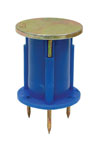
For more information on the products mentioned in this article visit the manufacturer’s Web sites.
• USG-DGLW concealed drywall suspension system: www.usg.com
• Sliptrack Systems, SLP-TRK Brand Slotted Top Tracks: www.sliptrack.com
• Hilti Pins: www.hilti.com
• Blue Bangers: www.simpsonanchors.com
• ProX Header: www.proxheader.com


Report Abusive Comment